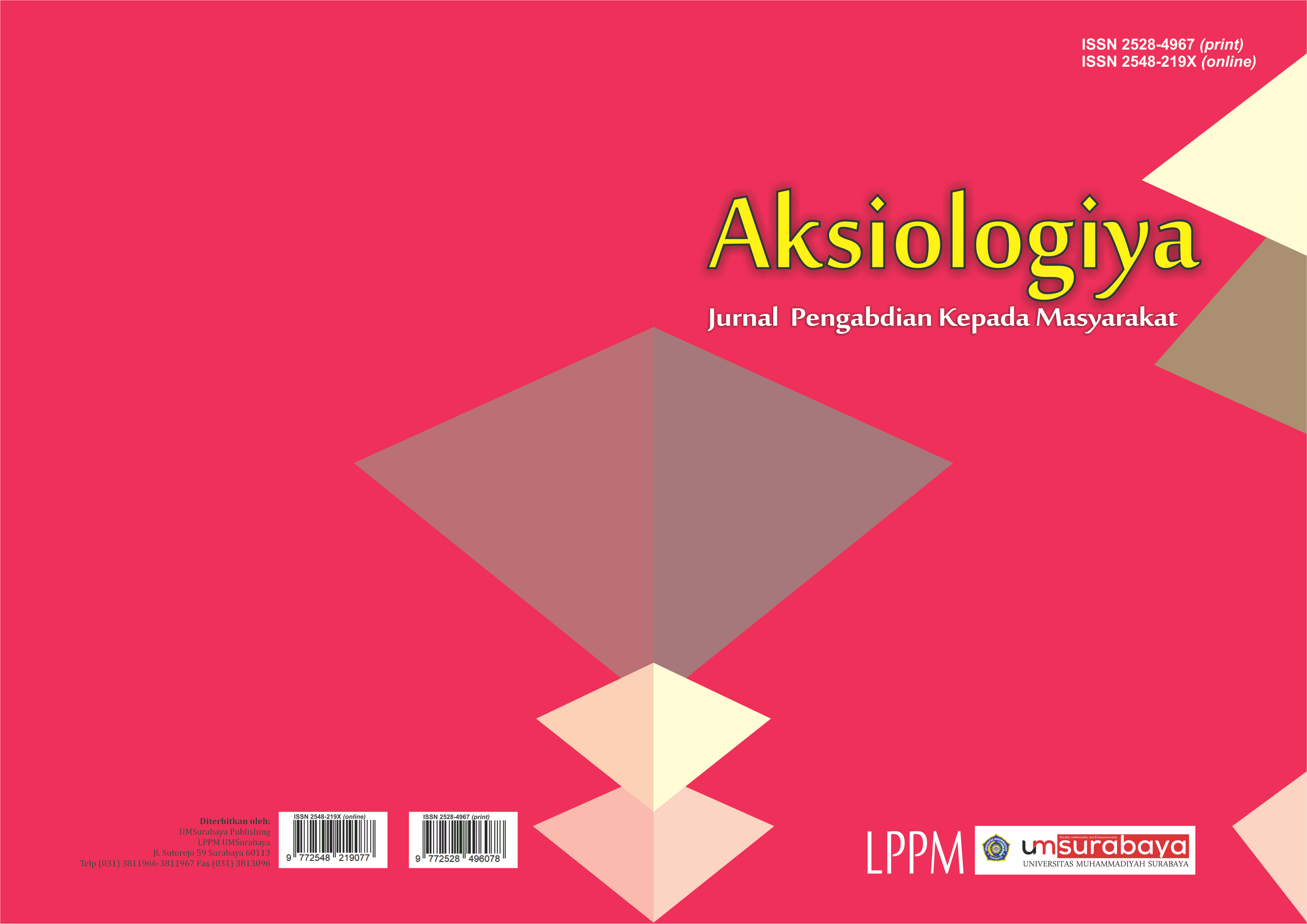Isi Artikel Utama
Abstrak
Implementation of neighborhood health center aims to reduce infant mortalityis accompanied by efforts to reduce the birth rate. For that selected priority programs such asmaternal and child welfare (MCH), family planning, nutrition improvement, immunization andprevention of diarrhea. IHC closely related with active community participation (participationmothers). Factors that influence the participation of mothers in the neighborhood health center activities include knowledge, attitude, affordability of health centers, social, economic, and health workers and cadres factors neighborhood health center.Methods this study uses an analytical methode with cross sectional approach. Total population 95 with a sample of 55 mothers, the samples were taken by simple random sampling. Data were collected by questionnaire and observation, then analyzed using statistical test Regrisi Binary Logistic with significance level of 0.05. The results showed that, the results of statistical tests Binary logistic regression showed knowledge factor (p = 0.000 <α = 0.05), showing the attitude factor (p = 0.002> α = 0.05) where health care affordability factor indicates (p = 0.003 <α = 0.05),and socioeconomic factors demonstrated (p = 0.010 <α = 0.05) and the factor of health workers and cadres posyandu (p = 0.355> α = 0.05). Based on these results it can be concluded that the knowledge factor, the affordability of the health service and social economy that affect the mother's participation in growth monitoring sessions.
Â
Â
Kata Kunci
Rincian Artikel
Hak cipta artikel dimiliki oleh jurnal AKSIOLOGIYA
Ciptaan disebarluaskan di bawah Lisensi Creative Commons Atribusi-NonKomersial 4.0 Internasional.
Referensi
- Ambarwati ER, Rismintari YS. AsuhanKebidanan Komunitas. Nuha Medika. Yogyakarta
- Arali. (2008). Catatan Ringan Tentang
- Perkembangan Posyandu. http://wordpress.com. Di akses tanggal 25
- Maret 2010
- Dana, IN. (2006). Upaya MeningkatanPeran Serta Masyarakat Melalui Analisis Faktor Stakeholder Posyandu Di Wilayah Kerja Puskesmas Denpasar Timur Kota Denpasar. http://adln.lib.unair.ac.id. Di akses tanggal 15 Maret 2014
- Departemen Kesehatan. (2006). Pedoman
- Umum Pengelolaan Posyandu. Jakarta
- Dinas Kesehatan. (2008). Profil Kesehatan Kabupaten Bojonegoro.Bojonegoro
- Hidayat, Alimul A. (2007). Metode Penelitian Keperawatan dan Teknik Analisis Data. Salemba Medika. Jakarta
- Intanghina. (2008). Peran Serta IbuBalita Dalam Kegiatan Penimbangan. http://wordpress.com. Di akses tanggal 5April 2014
- Muhaemin, A (2008). Beberapa Faktor Yang Berhubungan Dengan Partisipasi Ibu Balita Dalam Kegiatan Penimbangan Di Posyandu (Studi Kasus Di Desa Sidorejo Bendosari Sukoharjo). http://wordpress.com. Di akses tanggal 16 Maret 2014
- Notoatmodjo,S. (2003). Pendidikan danPerilaku Kesehatan. Renika Cipta. Jakarta
- Notoatmodjo,S. (2005). Promosi Kesehatan Teori dan Aplikasi. Renika Cipta. Jakarta
- Notoatmodjo,S. (2007). Kesehatan Masyarakat Ilmu dan Seni. Renika Cipta.Jakarta
- Notoatmodjo,S. (2010). Ilmu Perilaku Kesehatan . Renika Cipta. Jakarta
- Nursalam. (2008). Konsep dan Penerapan Metodologi Penelitian IlmuKeperawatan Pedoman Skripsi, Tensis, dan Instrumen Penelitian Keperawatan.Salemba Medika. Jakarta
- Oktavira, AT. (2007). Penerapan Indikator Peran Serta Masyarakat Dalam Kegiatan Posyandu Di Kelurahan Dupak Surabaya. http://adln.lib.unair.ac.id. Di akses tanggal 5 April 2010
- Rahaju, B dkk.(2007).Buku Pegangan Kader Posyandu. Dinas kesehatan propinsi Jawa Timur.
- Rohayu, SB. (2005). Beberapa Faktor Yang Berhubungan Dengan Partisipasi Kader Posyandu Di Wilayah Puskesmas Kedung Solo Kabupaten Sidoarjo Jawa Timur. http://adln.lib.unair.ac.id. Di akses tanggal 10 April 2014
Referensi
Ambarwati ER, Rismintari YS. AsuhanKebidanan Komunitas. Nuha Medika. Yogyakarta
Arali. (2008). Catatan Ringan Tentang
Perkembangan Posyandu. http://wordpress.com. Di akses tanggal 25
Maret 2010
Dana, IN. (2006). Upaya MeningkatanPeran Serta Masyarakat Melalui Analisis Faktor Stakeholder Posyandu Di Wilayah Kerja Puskesmas Denpasar Timur Kota Denpasar. http://adln.lib.unair.ac.id. Di akses tanggal 15 Maret 2014
Departemen Kesehatan. (2006). Pedoman
Umum Pengelolaan Posyandu. Jakarta
Dinas Kesehatan. (2008). Profil Kesehatan Kabupaten Bojonegoro.Bojonegoro
Hidayat, Alimul A. (2007). Metode Penelitian Keperawatan dan Teknik Analisis Data. Salemba Medika. Jakarta
Intanghina. (2008). Peran Serta IbuBalita Dalam Kegiatan Penimbangan. http://wordpress.com. Di akses tanggal 5April 2014
Muhaemin, A (2008). Beberapa Faktor Yang Berhubungan Dengan Partisipasi Ibu Balita Dalam Kegiatan Penimbangan Di Posyandu (Studi Kasus Di Desa Sidorejo Bendosari Sukoharjo). http://wordpress.com. Di akses tanggal 16 Maret 2014
Notoatmodjo,S. (2003). Pendidikan danPerilaku Kesehatan. Renika Cipta. Jakarta
Notoatmodjo,S. (2005). Promosi Kesehatan Teori dan Aplikasi. Renika Cipta. Jakarta
Notoatmodjo,S. (2007). Kesehatan Masyarakat Ilmu dan Seni. Renika Cipta.Jakarta
Notoatmodjo,S. (2010). Ilmu Perilaku Kesehatan . Renika Cipta. Jakarta
Nursalam. (2008). Konsep dan Penerapan Metodologi Penelitian IlmuKeperawatan Pedoman Skripsi, Tensis, dan Instrumen Penelitian Keperawatan.Salemba Medika. Jakarta
Oktavira, AT. (2007). Penerapan Indikator Peran Serta Masyarakat Dalam Kegiatan Posyandu Di Kelurahan Dupak Surabaya. http://adln.lib.unair.ac.id. Di akses tanggal 5 April 2010
Rahaju, B dkk.(2007).Buku Pegangan Kader Posyandu. Dinas kesehatan propinsi Jawa Timur.
Rohayu, SB. (2005). Beberapa Faktor Yang Berhubungan Dengan Partisipasi Kader Posyandu Di Wilayah Puskesmas Kedung Solo Kabupaten Sidoarjo Jawa Timur. http://adln.lib.unair.ac.id. Di akses tanggal 10 April 2014


